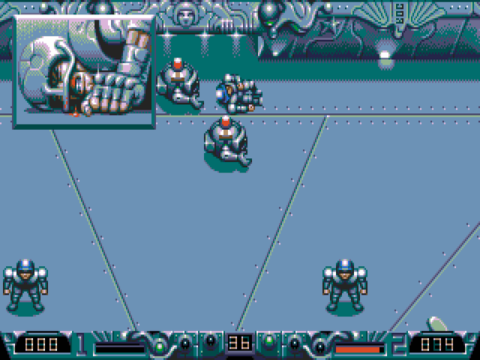
Speedball 2: Brutal Deluxe
Written by: Rik
Date posted: April 16, 2016
- Genre: Sport
- Developed by: The BItmap Brothers
- Published by: ImageWorks
- Year released: 1992
- Our score: 7
It’s the best part of 15 years since I last played and wrote about Speedball 2: believe it or not, my first review was prompted by the boxed (!) budget re-release of the game in 2001. Both the game and the write-up really should have been revisited before now. The latter was not only light on detail but also quite frankly wrong in places, and to a certain extent it was informed by anti-Amiga bitterness and the kind of cynicism that young people employ in a misguided attempt to be ‘edgy’. (There’s nothing wrong with a bit of pantomime anti-Amiga sentiment, of course, but it probably shouldn’t be the sole basis for coverage).
Like my other Amiga-based bête noire, Sensible Soccer, Speedball 2 regularly comes top of lists of ‘best 16-bit computer sports games’. Unlike Sensible Soccer, though, I’d not really ever given Speedball 2 enough opportunity to redeem itself in my eyes, and all I really had was a few patchy memories of being quite bad at it on Atari ST in 1991, and then again on PC in 2001.
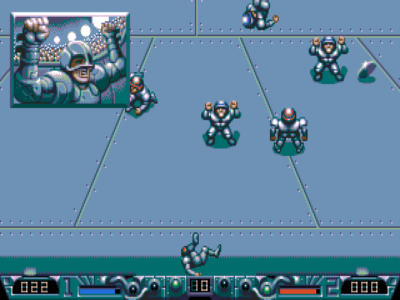
The inset picture might show some macho posturing, but the player sprite actually does quite a camp little jig upon scoring.
And I was wrong before. Speedball 2 has in fact aged surprisingly well. Hyper violent sci-fi sports games are usually as ill-conceived as futuristic hover racers, full of back-of-the-box hype about how the future is really exciting and dangerous, but proving markedly less thrilling than a game of fake football or golf, or pretending to drive a car that actually has wheels. Speedball 2, like Wipeout, is the exception.
A hybrid of football, handball, rugby, and, er, possibly pinball [Yep, that’s all bases covered – FFG reader], the basics come down to gaining possession of a small metal ball and throwing it into your opposition’s goal. There are, however, other ways of scoring points: lighting up stars on the side of the arena, hitting one of two domes located on the pitch itself, or causing an injury to an opposing player. There are no fouls or stoppages, and possession is regained by simply smashing into your opponent.
Other pitch features include a warp gate, into which you can throw the ball to disorientate your opponents, and a dome that makes the ball ‘hot’ and slices through players like they weren’t even there. There’s also a multiplier ramp, which, when activated, increases the value of all of your point-scoring options. Meanwhile, on-pitch pickups are dotted around, giving you permanent or temporary advantages during the match, or boosting your finances for later use.
My own experience with retro sports games suggests that the ones that often survive the test of time best are those that are fast-paced and have a simply control scheme, and Speedball 2 certainly meets both criteria. As with many 16-bit computer games, a one-button control scheme is employed: you press the button to throw (longer presses launch the ball higher), slide into an opposing player when you don’t have the ball, or jump for a high ball when no-one has it – there’s nothing more complex or convoluted than that. The frenetic pace and the frequency of physical contact between players does genuinely create an atmosphere of violence as promised. Hurling the ball forward to your attackers who then shove the goalkeeper to the ground and throw into an empty goal is, when it works, a perfectly legitimate tactic.
There are some problems. Defending is a bit tricky thanks to reduced visibility and the player auto-select. The goalkeeper, like in your work five-a-side kickabout, is the worst player, whom you also have to control, and his side to side movements and erratic diving mean you occasionally let in soft goals. Frenetic hacking of the only button available to get the ball clear is sometimes effective, although it does mean you sometimes accidentally hurl the ball into your own goal in a less than heroic manner. The multiplier is weird too – most of the time the opposition ignore it, unless you try to use it, at which point they sort of become obsessed and start swarming around it like flies. But, other than that, it still plays really well. It’s simple, fast and fun, and pretty close to exactly what you’d want from an arcade sports experience.
There are three game modes: Knockout, Cup and League. One thing they have in common is that you always control a team called Brutal Deluxe, and they’re always a pretty crap to start with. (You could also say the other thing they have in common is that they’re all effectively knockout modes, but we’ll get onto that). In Knockout you play against increasingly better teams while using the cash found on the pitch to upgrade your players’ skills. Lose and it’s game over. In Cup, matches are played over two legs, and in addition to upgrading your team’s skills you can use money to recruit star players with vastly superior stats. Most of the star players’ pictures depict snarling hard-nuts who look a bit mad, so they certainly stand out among your default squad full of Colins and Daves. (Swapping your players around, incidentally, seems a lot harder than it needs to be, and the management menu in general can be a bit of an arse to navigate).
League retains the management aspects of the cup mode, and the league format is spread over two divisions. I instantly gravitated to the longest and what I took to be most forgiving competition, but it’s not exactly the PES Master League. You can only save every four games, you have to win promotion in your first season, and then you have to win the league in your second. If you don’t, it’s game over. Furthermore, the points you score in each game count almost as much as the result, so grinding out narrow victories doesn’t always bear fruit. You’re pretty much always inferior to the best opposition teams, and when they smash your star player to a pulp, he isn’t just out of the match, his stats go down too. Brutal indeed.
An arcade challenge is indeed legitimate, although I’ve never particularly enjoyed it in a sporting context, where much of the appeal is often about the mundane weekly ebbs and flows rather than a single march to glory against progressively stronger opponents. I don’t necessarily think that a win in a sports game – even a silly future sci-fi sports game – should be like beating up M. Bison from Street Fighter II, or defeating an overpowered boss in an FPS, which is how it can sometimes feel here.
It’s a shame you have to have ‘game over’ in league mode: I imagine it would be hard enough to win the top division even if you could try again. I can imagine tales of 90s teenagers finally beating the game (and mega hard opponents Super Nashwan) after weeks and months of trying. But for a 34-year-old man with wizened hands and limited hand-eye co-ordination, it proved beyond my levels of skill and patience.
Such structural issues could of course be remedied by a new and updated version. But unfortunately, despite what I said last time, none of the various remakes have managed to recapture the essence of the original gameplay (see Speedball: A Brief History, above, for more), leaving this as the best possible version available. I should also point out that the PC version isn’t quite as fast and smooth as its 16-bit counterparts, no matter how much you fart around with DOSBox cycles, and its version of the (still rather catchy) theme music doesn’t quite match up either.
Still, the PC version remains very playable. The on-pitch action holds up well, and if there were more forgiving tournament options, I’d likely have played for much longer. So, finally, I admit it: Speedball 2 is one of those classic sports games from the 90s that does actually deserve a lot of the recognition it gets.

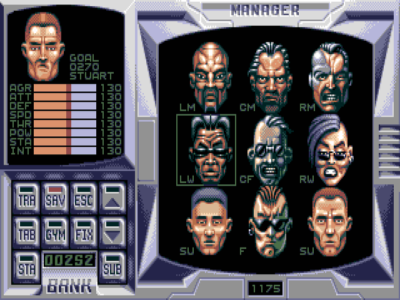
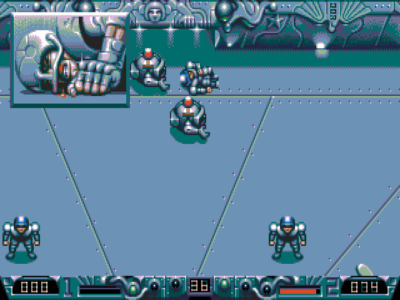
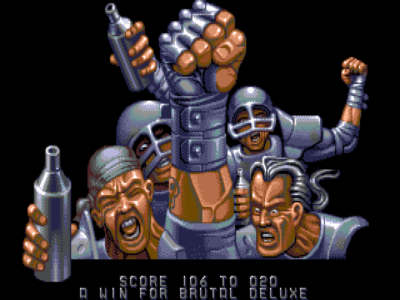

 Posts
Posts
Hey, another game inspired by Rollerball, a sci-fi movie from 1975!
Though, it seems that this one actually works.
April 22, 2016 @ 11:58 am
I keep meaning to check out Rollerball. As long as I get the original and not the re-make with LL Cool J and Chris Klein from American Pie.
April 22, 2016 @ 12:07 pm
Yes, leave the remake: it is crap.
Another film of similar ambientation that you may like is The Blood of Heroes (or Salute of the Jugger) by David Webb Peoples and with Rudger Hauer.
April 26, 2016 @ 11:57 am
For the longest time I thought the team explosive lords was called explosive loads
March 11, 2022 @ 8:26 am